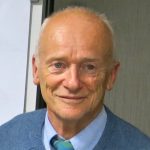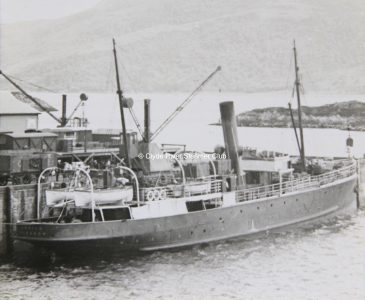
Bigger and better? Isle of Lewis and Loch Seaforth meet at Stornoway on 16 March 2015 (© Mark Nicolson)
Colin Tucker, former Purser of the 1947 Loch Seaforth and a Lewis resident, reflects on the developing size and sophistication of vessels that have served the island over the past 100 years.
The centenary of the Iolaire disaster in January 2019 raised awareness of the size, or rather the lack of it, of the Stornoway mail boat 100 years ago, MacBraynes’ Sheila. During the commemoration many comments were made by people who could not believe Sheila had a certificate allowing her to carry almost 300 passengers. ‘Where did they put them all?’ was asked on many occasions.
The simple answer is that most of the passengers travelled third class, or steerage, in basic accommodation which did not necessarily include that most basic of luxuries, a seat. These were the conditions under which hundreds of fisher girls were forced to travel, conditions which were so bad as to be complained about at Westminster.
But on 31 December 1918 it was only to the good that so many of the returning servicemen were able to be packed on board, allowing them to return home safely.
Since the days of Sheila, Stornoway has been served by seven other mail boats or ferries, and each succeeding ship has been bigger and had better accommodation.
Sheila
Sheila was already 14 years old when Iolaire struck the rocks known as the Beasts of Holm, but she had long had the reputation of being the ship which made her way across the Minch in all weathers, hardly ever missing a crossing even if it meant taking over 10 hours on the trip, or making several attempts to proceed beyond Applecross. With a speed of 14 knots, Sheila also had the distinction of making the fastest crossing from Kyle, beating the previous time of four hours and 47 minutes.
The ship was ordered from Inglis of Pointhouse on the Clyde, to replace a number of unsatisfactory vessels which had caused many complaints during the last decade of the 19th century. She was to be ‘an up-to-date steamer fitted with electric light and all modern improvements’. With a gross registered tonnage of 280, a length of 150 feet, beam of 23 feet, and drawing 10.5 feet, Sheila was a tiny vessel compared to today’s ferry, which is more than twice her length.
Like all new ships she was described in fulsome terms on her first arrival at Stornoway — ‘a handsome craft to outward appearance, and her inward fittings are in keeping.’ She had ‘a number of cosy two-berth cabins and a splendidly appointed smoking room. Another feature (was) the placing of the galley on the top deck, thus removing a cause of complaint to weaker stomached passengers who used to be upset by the smell of cooking on the lower deck.’
She was also said to be a ‘a fine sea boat, being fitted with rolling chocks to steady her in rough weather’. The report concluded that ‘with a fine ship and splendid officers, the public can now be sure of a comfortable trip over the Minch.’
Sheila was not without her critics. The MP for Ross and Cromarty stated that ‘she is constantly late in her arrival in Stornoway’, while the conditions endured by steerage passengers, in particular the many fisher girls, were far from satisfactory. The situation was resolved when the career of Sheila came to a sudden end in the early hours of 1 January 1927: she ran aground near the mouth of Loch Torridon, fortunately without loss of life, and was eventually declared a total loss.
Lochness
It was not until 1929 that a long-term replacement for Sheila appeared. This was Lochness. The contract for the ship specified the vessel would have ‘a speed not less than twelve knots….and with a length of 175 feet.’ In the eyes of many this was totally unsatisfactory, resulting in a ‘deluge of telegraphic and other protests’, with the Stornoway Council wanting a speed of no less than 14 knots and a length of 250 feet.
What resulted was somewhere in between, the new ship having dimensions of length 208, breadth 34, and draught 10.5 feet, and a speed of 14 knots. Her gross tonnage of 777 was almost three times that of her predecessor, and she was one third longer.
But it was the amount and quality of her accommodation which showed the biggest advance. It was reported that ‘The stately appearance of this new MacBrayne liner bespeaks seaworthiness and comfort and it is confidently expected the vessel will quickly establish herself as a prime favourite with travellers between the mainland and the Isle of Lewis.’ There was accommodation for 428 passengers, in conditions which were in every way superior to that on Sheila.
For the first class passengers there were nine deck cabins and five state rooms, a finely furnished dining saloon, a smoking-room and a lounge, as well as a spacious shelter deck and promenading space on the boat deck. Third class passengers were provided with a dining room, a smoking-room, ladies and gentlemen’s sitting-rooms and ample promenading spaces. The ship was described as ‘a miniature ocean liner’.
In spite of all this initial praise it was less than 10 years before, in 1936, a number of complaints about Lochness suggested she was already considered to be unsatisfactory. This was not with regard to her size, but her lack of speed and inadequate accommodation.
It was claimed that although supposed to cross the Minch in four and a half hours, Lochness regularly took about an hour longer. In a rather extreme statement, it was stated that this was ‘the slowest crossing in the whole of Great Britain, where a mail service is concerned, with the exception of other services operated by the same company.’
The accommodation of both first class and steerage was considered inadequate. There was both insufficient seating and sleeping facilities in first class, while third class was considered to be ‘far below present-day standards’.

Colin Tucker as Purser of Loch Seaforth c1968
A new ship was promised in 1938, but the onset of the Second World War delayed her appearance.
Loch Seaforth (1947)
The new ship, Loch Seaforth, finally appeared in 1947, and was a larger vessel all round than Lochness. Her length of 240 feet was about 20 per cent more, and a tonnage of 1,125 was almost a third greater. In terms of accommodation there was both more of it, and of a higher standard. This included a first class observation lounge, ‘apparently modelled on that of the Queen Mary, with large armchairs on which to relax and watch the ever-changing scenery through large windows’. The third class lounge was thought to be better than the first class saloons of older steamers. Cabins were provided for both first and third class, and an innovation was the provision of cubicles, with basic bed rug and pillow, also for both classes.
Iona
When the time came to replace Loch Seaforth, the new ship — MV Iona — had almost the same dimensions, being only four feet longer. What was larger than on Loch Seaforth was the car-carrying capacity.
Whereas Loch Seaforth was able to load only a handful of cars by derrick on her foredeck, Iona had capacity for 47 vehicles, driven on and off through bow doors and stern ramp, or by means of a hoist on her open stern deck.
This was, of course, a sign of the changing times. When Loch Seaforth had been built in 1947, few people were car owners, but with the passing of almost a quarter of a century the demand to take cars across the Minch, whether belonging to locals or to the steadily growing number of tourists, had increased greatly.
Iona initially opened a car-carrying service from Mallaig and Kyle of Lochalsh to Stornoway, before inaugurating the new route from Ullapool in 1973. The ship had not been intended to operate to Stornoway, and did not prove popular, either with respect to her passenger accommodation or the fact she could only carry nine commercial vehicles.
Clansman
This ship replaced Iona in 1973. Originally built in 1964, she was underwent a major reconstruction at Troon in 1972-73, when she was lengthened by 30 feet and given drive-through facilities to operate between Ullapool and Stornoway. Once again she was bigger than her predecessor, although not by any considerable amount. She was about 20 feet longer, with a tonnage of 1,707 as against Iona’s 1,192. Her car deck had a slightly greater capacity, being able to take 50 cars and 14 lorries.
Suilven
Both Iona and Clansman could be considered as stop-gap vessels to replace Loch Seaforth. It was necessary to obtain a permanent replacement, which appeared in the form of Suilven, bought off the stocks in 1974 from a Norwegian shipbuilder.
Another slight increase in length, to 283 feet, was apparent, but again it was the ship’s vehicle carrying capacity which showed a huge difference. With the introduction of mezzanine decks, 120 cars could now be carried. The ship set new standards for the Lewis service and attracted heavy numbers of commercial vehicles. It was the success of Suilven in attracting ever-increasing traffic which prompted the building of her replacement.
Isle of Lewis
The arrival of Isle of Lewis in 1995 saw a huge increase in the size of the Stornoway ferry. With a length of 331 feet and a beam of 61 feet, she dwarfed Suilven when the two ships appeared next to each other. The relative tonnages were 1,980 and 6,753. She could carry almost 25 per cent more cars and had capacity for 680 passengers. A whole extra deck of accommodation added to her impression of size, confirmed when aboard by the size of the lounges, restaurant, bar and wide alleyways.
She was just what the route really needed at this time: a large vessel which was capable of dealing with both local traffic and the ever-increasing tourist vehicles and passengers, as well as the numerous lorries which required shipment from the mainland.
Loch Seaforth (2014)
Twenty years after the arrival of Isle of Lewis traffic had grown to make her capacity inadequate. While it was argued that two smaller ships would be ideal, the situation was that one even larger ferry would be introduced.
The new Loch Seaforth looks, and is, bigger again. Her length is 380 feet, 50 feet longer than her predecessor. The amount of passenger accommodation is similar, but the extra length is taken up by an open vehicle deck at the stern.
The appearance of size is increased by a blunt bow, enclosed decks, with the bridge raised half a deck higher and by funnels built a deck higher. When alongside at Stornoway, especially at times of high tide, Loch Seaforth totally dominates the town, dwarfing the Town Hall and its clock.
It would be interesting to speculate what size the next ferry will be when a replacement is required. Will there be yet another increase in size, or has the optimum now been reached? If the pattern of the last 117 years continues, with the present ship nearly two-and-a-half times the length of the mail boat of 1904, the next Suilven or Isle of Lewis will be a massive vessel indeed.
All photographs on this website are protected by copyright law. Please do not reproduce them on Facebook, Pinterest or other public platforms without first asking permission from info@crsc.org.uk
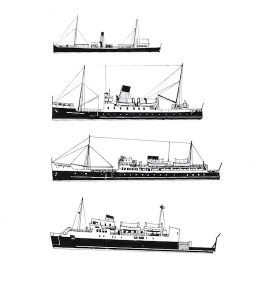
Does size matter? From the top: Sheila, Lochness, Loch Seaforth and Iona were all considered a big improvement on their predecessors
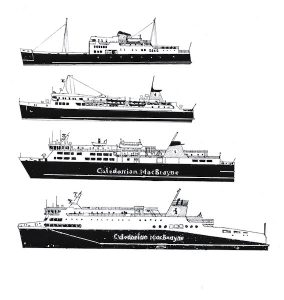
Would two smaller ferries be more suitable for the Stornoway run than one big boat? From the top: Clansman, Suilven, Isle of Lewis, Loch Seaforth
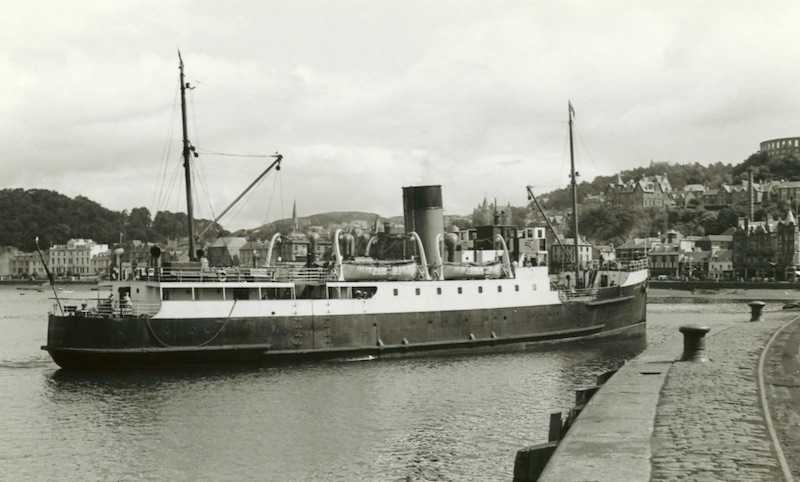
Lochness at Oban c1950, after she had been displaced from the Stornoway service by the 1947 Loch Seaforth (© CRSC)

Loch Seaforth entered service on the Stornoway mail run in December 1947. She is pictured at Kyle of Lochalsh in the mid 1960s, looking somewhat the worse for wear for her daily crossings of the Minch (© CRSC Roy Hamilton Collection)
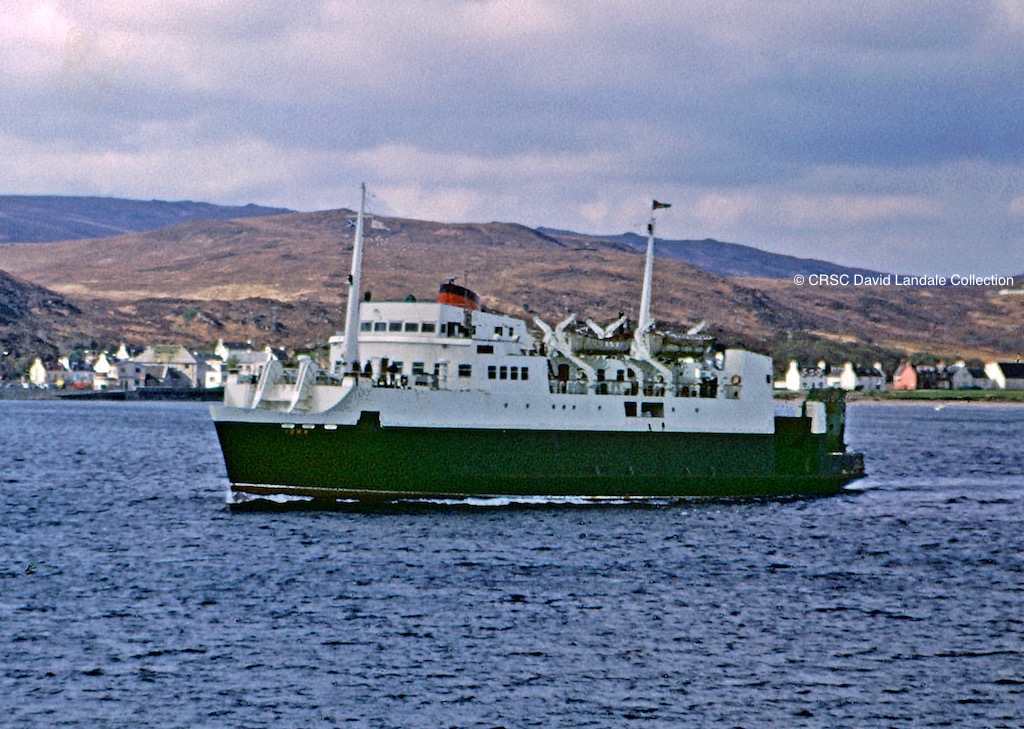
Iona, pictured off Kyle of Lochalsh on 2 May 1972, had roughly the same dimensions as the 1947 Loch Seaforth, but her vehicle carrying capacity was vastly superior. She ran initially from Kyle, before inaugurating the new route from Ullapool in 1973

Clansman heads out of Loch Broom on 19 June 1974, during her brief interlude on the Stornoway service. Copyright photo by Lawrence Macduff
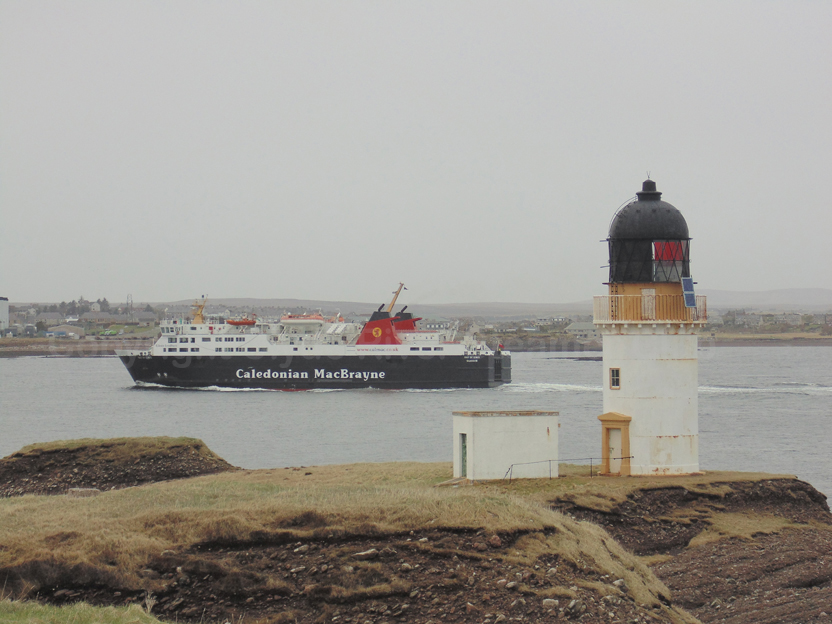
Isle of Lewis passes Arnish Lighthouse on 6 March 2014, a few months before before being ousted from the Stornoway run by a new Loch Seaforth (© Mark Nicolson)
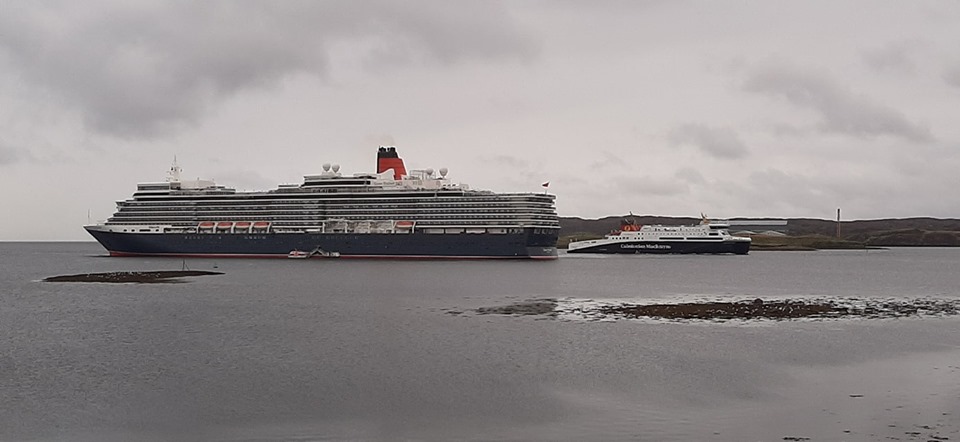
Loch Seaforth may be the biggest ship to have served on the Stornoway run, but she is still dwarfed by cruise ships like Queen Elizabeth. The contrast was beautifully captured by Mark Nicolson at the entrance to Stornoway Harbour on 9 September 2019
MORE BY COLIN TUCKER:
Crossing the Minch — Variations on a Theme
The future of the Outer Hebrides, 40 years ago
Gleanings from the ‘Highland News’
More Gleanings from the ‘Highland News’
How well do you know your CalMac lions?
Colin Tucker’s widely admired book Steamers to Stornoway is available in the CRSC Shop. His memoir of life aboard the 1947 Loch Seaforth can be read in the 2013 edition of the CRSC magazine Clyde Steamers.
This is a good time to join CRSC. Click here for your £10 membership and take advantage of all the benefits.
Published on 3 November 2019












